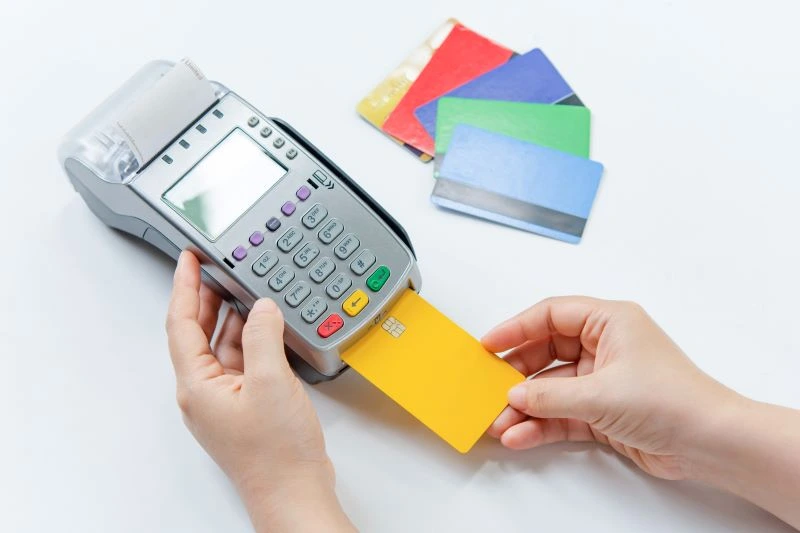New business owners may initially encounter the term "merchant account" without fully understanding its importance, only to later discover that it functions as an essential part of their payment operations. With the right merchant account, businesses can accept payments seamlessly. If you're unsure about where to begin your search for the perfect one—we've got you covered. This guide delves into the fundamentals of what a merchant account entails, explains the various types available, and provides step-by-step insights on how to initiate the account-opening process. Let’s dive in!
What Is a Merchant Account?
A merchant account is a specialized type of bank account designed to allow businesses to accept payments from customers. If you want to accept payment via credit cards, debit cards, or other electronic payment methods, you’ll need access to a merchant account.
It’s unique because a merchant account allows you to move money. In other words, it’s not an account that sits there with a balance like a traditional checking or savings account. It’s instead an intermediary account, set up and controlled by your payment processor, that money flows through.
Advantages of Having a Merchant Account
When choosing to accept payments through a merchant account, there’s more to it than just accepting payments. Below are the advantages of a merchant account.
Ability to Accept Card Payments
The first and biggest advantage of a merchant account is that it enables your business to accept a wide range of payment methods, including credit and debit cards. This expands your customer base and improves their experience through added convenience.
Credibility and Trust
Next, Accepting card payments can enhance your business's credibility and trustworthiness in the eyes of customers. Many consumers prefer card payments for security and ease of use.
Dedicated Assistance
When you have your own merchant account, you’re essentially setting up a partnership with a payment processor. Some alternatives to merchant accounts (which we’ll get to below) leave you unsupported when problems arise.
Increased Sales
Card payments tend to lead to higher sales, as customers tend to spend more per transaction when they can pay with cards instead of the limited amount of cash they have on their person.
Flexible/Custom Solutions and Pricing
When you set up a merchant account of your own, you can more or less choose a lot of its parameters to fit your business. This allows for often better pricing and functionality than competing solutions (again, more on those later).
Online and Mobile Payments
Truly, it’s almost impossible to have a website that converts sales without a merchant account. It facilitates online and mobile payment processing, arguably essential for eCommerce and businesses with an online presence.
Business Insights
Most merchant account providers also offer tools and analytics that can help you gain insights into your customer behavior and sales trends. An invaluable tool as you look to grow and scale over time.
How Do Merchant Accounts Work?
Now you have a vague idea of what merchant accounts are, but the picture becomes much clearer when you can see it in practice. Here’s a step-by-step overview of where merchant accounts fit:
Step 1: Customer Makes a Purchase. The process begins when a customer decides to make a purchase from your business.
Step 2: Payment Information Comes In. To complete the purchase, the customer provides their payment information. They’ll either hand you a physical card or type in the necessary card information such as card number, expiration date, and CVV.
Step 3: It Moves Through the Payment System. The payment information is securely transmitted from a point-of-sale system (this could be a payment gateway for online transactions or a physical card reader for in-person transactions).
Step 4: Authorization Request. The payment system reviews and sends an authorization request.
Step 5: Bank Verification. Your bank (acquiring bank) communicates with the cardholder's bank (issuing bank) to determine whether the transaction is valid and if the customer's account has sufficient funds to cover the purchase. This step verifies the legitimacy of the transaction.
Step 6: Authorization or Decline. The banks send a response back to the payment system. If the transaction is approved, it includes an authorization code. If declined, it provides a reason.
Step 7: Settlement. At this point, all you have is authorization—no money has moved yet. Instead, these authorization codes gather until settlement. Settlement typically occurs in a single batch submission at the end of the business day.
Step 8: Batching and Clearing. At the end of the day, you’ll submit your batch, and the involved banks will verify and reconcile the transactions.
Step 9: Funds Transfer. After clearing, the funds go into your merchant account.
Step 10: Payout. Then, your payment processor transfers the funds to your regular business bank account.
Merchant Account Types
Let’s list a few of the types of accounts you may be interested in opening depending on your business model/type:
- Retail. A retail account is designed for brick-and-mortar businesses that primarily conduct face-to-face transactions with customers. They’ll typically connect their account to a point-of-sale (POS) system or card terminal to process card payments.
- Industry-specific. An industry-specific merchant account is a merchant account that is specifically for your business type. It's a tailored payment solution that meets specific challenges that your industry sees.
- eCommerce. eCommerce businesses require specialized merchant accounts to accept payments over the Internet. These accounts integrate with online shopping carts and payment gateways to enable online transactions.
- Mobile. Mobile merchants, most commonly food trucks, pop-up shops, farmers market/flea market shops, and home service providers, use mobile merchant accounts. These accounts allow them to accept card payments using mobile card readers connected to smartphones or tablets (through WiFi or 3G/4G).
- Mail Order/Telephone Order (MOTO). MOTO accounts are not nearly as popular as they once were, but businesses that primarily accept payments through mail or telephone orders (for example, catalog retailers) use MOTO merchant accounts. Transactions are manually keyed into a virtual (web browser-based) terminal.
- High-Risk. Certain businesses are considered high-risk for various reasons, such as CBD, adult entertainment, gambling, and subscription services, which may require high-risk merchant accounts. These accounts often come with higher fees and stricter terms due to their increased risk of chargebacks and fraud.
Opening a Merchant Account
Opening a merchant account is a relatively simple process, but may take a few days (up to a few weeks) from start to finish. Thanks to the Patriot Act, there’s a lot of personal verification that needs to happen before your account can accept payments. But once your account is up and running, you’ll be grateful for the customized account, tailored support, and costs available to you.
To open an account, you’ll want to:
- Determine your needs. Decide the type of merchant account you’ll need, and what functionality you’ll want from your payments system (like inventory, multiple currencies, appointment booking, website integration, or recurring billing, for example).
- Start looking for providers. Next, you’ll want to take your wish and need lists around to different providers to see what they can help you with.
- Fill in an application. Once you’ve settled on a provider, it’s time to fill out an application. The application will request specific details about both you (and any other owners) and the business entity. Review things like terms, pricing, contract length, etc. Once signed, your application will go through an underwriting process.
- Provide supplemental documents. To verify you and your business, the merchant account provider may need supplemental documents like bank records, credit reports, passport photos, tax records, articles of incorporation, business licenses, etc.
- Equipment integration. Once you’ve been approved, the provider will set up your merchant account and program/integrate your equipment with your account details.
- On-site setup. Next, you’ll receive your equipment either physically or electronically and set it up in your work environment. You’ll test it and complete PCI verification to ensure it’s up and running as it should be.
- Start accepting payments. Finally, your account will be activated and you can start accepting payments.
What to Know Before Getting a Merchant Account
Beyond what we already have discussed, here are a few additional things you should know before agreeing to get a merchant account from a provider:
- Contract Terms and Termination Policies. Make sure you understand how long the agreement you sign is for and what the penalties are for early termination.
- Equipment Leases. Make sure that if you’re renting equipment, it’s a cancelable lease (not an “uncancelable lease”) and being offered for a price that makes sense considering the cost of equipment For example, not paying $50 a month for a $200 terminal.
- Processing Timeframes. If you close your batch on Monday, how long will it take to see those funds deposited? What about Friday? Understanding these terms will set you up for better cash flow expectations in the long term.
- Customer Support. If you call, can you reach a live support representative quickly? If your system malfunctions or goes offline for any reason, you’ll want good customer support behind your merchant account.
- Backup Payment Solutions. If a thunderstorm takes down power or the internet cuts out, how will you accept payments? Look into a manual imprinter machine or another backup analog method.
Merchant Account Fees
One of the biggest concerns with opening a merchant account is the costs associated with them. Sourcing a reliable quote is important when vetting providers. Oftentimes, business owners will take the quote to another provider to see if it can be matched or beat.
Additionally, verify that the agreed-upon fees show up on your contract. Doube-check fees are not added without your knowledge and if some are, ask questions to the representative.
Lastly, monitor your monthly statements for increasing/changing fee statements, additional fees you don’t recognize, and the correct average percentage cost. For example, if you process $10,000 in credit card transactions each month, your fees should remain relatively consistent.
Alternatives to Merchant Accounts
There are some alternatives to merchant accounts that you may have seen or considered before. Payment service providers (PSPs) are one of the most popular. If you have seen Square, PayPal, or Stripe you’ve seen (and potentially used) a payment service provider. There are also peer-to-peer payment methods rising on the scene today including Venmo, CashApp, and Zelle.
So let’s talk about how they differ from a full merchant account.
Merchant Accounts Vs. Payment Service Providers
To describe the difference between a merchant account and a payment service provider, we'll use an analogy. Compare a merchant account to setting up a brand new phone plan with a company like T-Mobile or Verizon. You get to choose the number of minutes, data, and equipment to make sure it’s exactly what you want. When something on your plan needs to change, you can call your provider and get direct support. That’s what it’s like to have a merchant account.
Now imagine you’ve added a line to an existing phone plan. You can make requests for the number of minutes, data, and equipment you get, but you can only work within the confines set by the main account holder. They control the price of the line, and your access to the account, can shut you down or remove you at any point, and handle all the support for you. They can also impose their own “controls” on your account. That’s what it’s like to have a PSP (like PayPal, Square, or Stripe). It’s quick and easy to set up, but your options, control, equipment, and costs are all already set for you, making it harder to grow your business.
Peer-to-Peer Payments
Peer-to-peer payments, on the other hand, are newer to the scene and are closer to cash or ACH payments. They’re the brands like Venmo, CashApp, or Zelle you’ve probably seen and used before in your personal life.
These transactions are cheap to process, but unless the other person already has an account and knows how to use it, they’re also ripe with opportunities for fraud or human error that harms your business. So while it’s a great additional/secondary tool to add to your payments toolkit, it’s not a great primary payment option.
Concluding Thoughts on Merchant Accounts
Merchant accounts provide safety, flexibility, support, and the ability to grow/change over time, which makes them one of the best options out there for accepting payments. While there are some things to look out for, with a little research you can find a merchant service provider that acts more like a partner than a vendor.
Frequently Asked Questions (FAQs)
A business bank account serves several distinct functions for your business including:
- Storing a balance
- Allowing deposits, transfers, withdrawals, and bill payment
- Potentially creating interest for you
In other words, it’s primarily designed to hold your money. A merchant account, on the other hand, is a type of account designed primarily to communicate, route, and process money. It has several functions including:
- Communicating with other banks
- Routing payments
- Requesting authorizations
- Handling payment clearances
- Settling customer transaction
It is not designed to hold a balance for you.
Yes, a merchant account is a tool for businesses to accept payments from their customers. If you do not have a business you do not need or have the ability to create a merchant account.
While not always recommended, many merchants choose to use their business bank account provider to create a merchant account. While it sounds convenient, this not only gives them access to your cash in your account but also your cash flow. They often charge more than a non-bank merchant account provider, and this relationship can cause problems in the event you owe them on a loan, for example.
It can take anywhere from a few days to a few weeks from start to finish to set up a merchant account because of processes like underwriting, equipment setup and delivery, and testing.
You need access to a merchant account to accept online payments through a customer’s debit or credit card. You can get access to one through a merchant services provider.
Depending on the age, history, and legal structure of your business, your credit history may come into play. If your business is brand new and has no history, is a sole proprietorship or partnership, or has cash flow problems, your personal credit history may be taken into consideration during underwriting.
No. Thanks to the Patriot Act, you and your business will need to undergo an underwriting and verification process to get a merchant account. This is to prevent fraudsters from creating an account and processing fraudulent cards without oversight.






